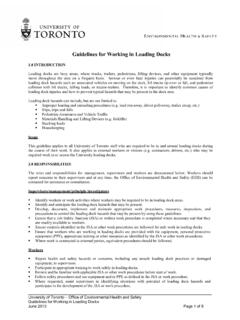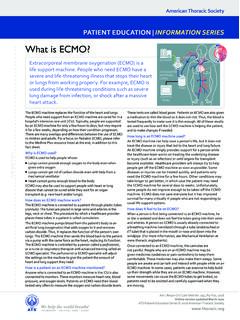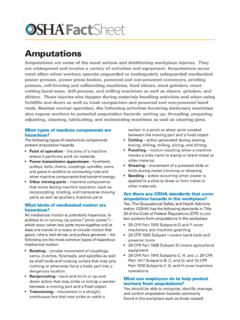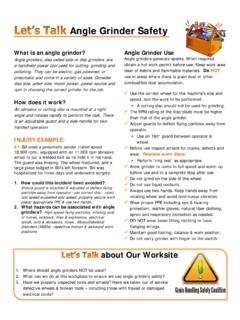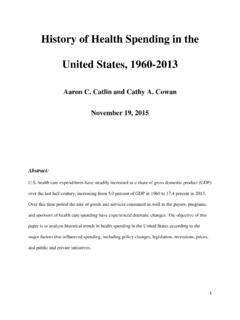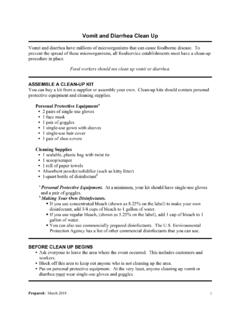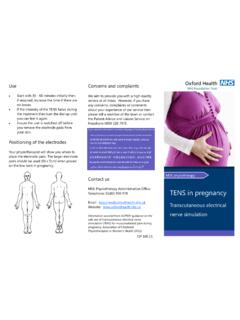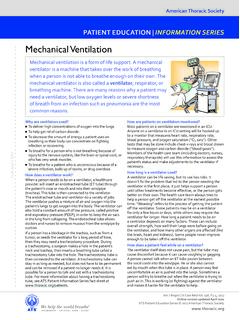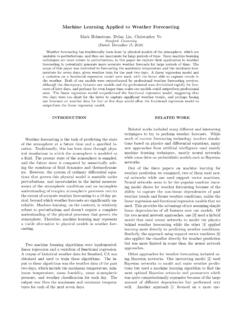Transcription of Machine Safety Guidelines - Environmental Health & Safety
1 Machine Safety Guidelines Introduction Workers and students working in Machine shops, or using machines and power tools in other areas, are faced with a potential risk of injury from a number of hazards. These risks can be reduced by ensuring that both the employees and the students know the safe operating procedures. Only persons trained and knowledgeable in the use of specific equipment shall be allowed to use that equipment and all work must be performed in accordance with applicable regulatory requirements. Applicable regulatory requirements include, but are not limited to the Ontario Occupational Health and Safety Act and Regulations for Industrial Establishments (Reg. 851) and other applicable standards and Guidelines ( CSA Standard Z432-04 (R2009). Safeguarding of Machinery).
2 The purpose of this guideline is to provide department management with guidance on the safe use of machines including general information for safe use and requirements for training, maintenance and written work procedures. Hazards associated with machines, power tools, and Machine shops can include, but are not limited to: Being struck by ejected parts of the machinery Being struck by material ejected from the machinery Contact or entanglement with the machinery Contact or entanglement with any material in motion Electrical hazards Chemical hazards (from cutting fluids, lubricants, etc.). Burns, cuts and other injuries from materials or substances used/exhausted by the machinery Noise levels Material Storage and handling (manual material handling, ergonomics). Safe access to/from machines (access, egress).
3 Environment in which the Machine is used (in a Machine shop, or in a work site). Objective The purpose of this guideline is to provide University of Toronto departments that have Machine shop areas and/or Machine shop-type equipment and powers tools with general guidance on developing their own safe work procedures. Due to the variety of activities that occur at the University's three campuses, each department should develop their own safe work procedures based on the types of activities, machines, power tools and hazards present. Responsibilities University of Toronto Office of Environmental Health and Safety Machine Safety Guidelines August 2015. The roles and responsibilities for management, supervisors and workers are documented below. Workers should report concerns to their supervisors and at any time, the Office of Environmental Health and Safety (EHS) can be contacted for assistance or consultation.
4 Supervisors/Managers/Principal Investigators Identify and anticipate any Machine hazards and Machine users that may be present in their work area. Develop, document, implement and maintain appropriate work procedures, measures, inspections, and precautions and emergency procedures to control the hazards that may be present by using these Guidelines and in accordance to applicable legislation and standards. Where necessary, complete a Job Safety Analysis (JSA). Ensure that all designated Machine users (staff, faculty students, etc.) have adequate training on the operation of machines and power tools and documenting that such training has taken place ( Department Orientation Checklist, Attendance Sheet). The content of the training will depend on the type of activities, machines, tools and hazards present Section, Section 3, C: Training for guidance.
5 Ensure all written procedures are readily available to Machine users. Ensure that only qualified persons operate the machines and the power tools. Schedule the use of machines and power tools. Ensure that the machines and power tools are maintained and in good condition. Establish Machine -specific Lockout Tagout (LOTO) procedures. Ensure that all persons operating the equipment are provided with and wear the appropriate personal protective equipment (PPE). Where PPE is required, signage shall be posted in the work area, and/or provided in work instructions. Ensure that all persons working with machines and power tools follow department developed work procedures. Machine and Power Tool Users/Workers/Students Participate in appropriate training to work safely with machines and power tools.
6 Review and be familiar with applicable work procedures before start of work. Operate the machines and power tools according to work procedures Follow Safety procedures and use equipment and/or PPE as defined in the work procedure. Inspect any equipment for defects prior to its use. Report Health and Safety hazards, injuries, or concerns, including any unsafe Machine practices or damaged equipment, to supervisors/principal investigator. Practice good housekeeping and hygiene Where requested, assist supervisors in identifying situations with potential of Machine hazards and participate in the development of the JSA or work procedure. University of Toronto Office of Environmental Health and Safety Machine Safety Guidelines August 2015. Office of Environmental Health & Safety Provide consultation and assist in Machine Safety as needed.
7 Update and maintain these Guidelines on a regular basis and/or when new information becomes available. General Controls for Reducing Machine Hazards Steps which can help reduce Machine hazards fall into the following categories: A. A: Hazard Identification B. Work Procedures C. Training D. Emergency Preparedness A: Hazard Identification A workplace hazard is any equipment, procedure, material, environment or situation that may cause personal injury or illness, or property damage. Workplace hazards need to be anticipated, identified, and evaluated based on the degree of risk and exposure. Once the hazards have been identified and evaluated, appropriate control measures should be implemented to minimize the likelihood of injury in the workplace. Some common Machine hazards and general Safety measures include (click link to go directly to that section): General Machinery and Equipment Hazards and Controls General Metalworking Machine Safe Practices General Woodworking Machine Safe Practices Powered Hand Tools Specific Equipment Hazards Ergonomics, Material Handling and Storage Chemical Hazards Electrical Safety Fire Hazards Machine Shop Work Environment This above list is not exhaustive of all the hazards that may be present in Machine shops or when working with machines.
8 Supervisors/PI must determine if there are any additional hazards that may be present. This can be achieved by completing a Job Safety Analysis (JSA) for tasks involved where necessary. B: Work Procedures Each workplace is different and has different hazards. Based on the hazards identified above, written work procedures should be provided to Machine users on the work they are expected to perform, how to perform this work safely, and what types of tools or PPE they may need to perform this task. This includes work activities that may occur every day, maintenance activities University of Toronto Office of Environmental Health and Safety Machine Safety Guidelines August 2015. that occur periodically ( monthly, annually), and emergency procedures. Here are some examples of work procedures that can be developed: 1.
9 Procedures on using, inspecting and maintaining equipment (machines, power tools) . in some cases, additional workplace procedures (such as Lock Out/Tag Out procedures). may be required to supplement manufacturer manuals/instructions. 2. Procedures on handling, mixing, storing and disposing of chemicals and materials used with the machines. 3. Procedures on the orientation of Machine users (training requirements, PPE, etc.). 4. Procedures for ergonomic aids ( pallet hand trucks). 5. Procedures for emergency response and injury reporting. C: Training Based on the above, appropriate training should be provided as follows: 1. Equipment specific training. Training should be provided on the safe use of equipment and tools, to include routine operations, storage, maintenance and the use of protective devices such as guards, interlocks, two-hand controls, electronic sensing devices, push sticks, emergency stops.
10 Where PPE is required, training should be provided on the proper use and maintenance of the PPE. 2. Additional hazard specific training, such as (but not limited to): Ladder Safety Lock Out/Tag Out Manual Materials Handling Noise Respiratory Protection Working in Hot/Cold Environments Workplace Hazardous Materials Information System (WHMIS). Some of these courses are available online through EHS, or are alternative instructor-led courses. Select specialty hazards (asbestos, lasers, radiation, silica, lead etc.) may have additional requirements. Contact the EHS office for further information if required, or browse available courses online at the EHS website ( ). 3. Worksite specific training, such as emergency preparedness ( where to find emergency equipment, eye wash, first aid kits, fire extinguishers, emergency contact, etc.)


